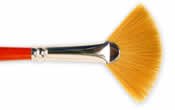Brush Shape Chart
As you may have noticed, paint brushes come in all sorts of shapes. Although different manufacturers apply wildly varying styles and names to their brushes, there are certain shapes that are common to nearly every brand. Traditionally, short handled brushes are used for watercolor and ink painting. Long handled brushes are used for oils and acrylic paints. These are the most common paint brush shapes.
These are by no means all of the styles of paint brushes that you're likely to see. There are all kinds of specialty brushes manufactured for every medium. Luckily, finding the brush that's ideal for your project is a snap! You can purchase brushes of every shape and size at discounted prices at MisterArt.com.
| Brush Shape | Description | Usage | Media | Hairs |
|---|---|---|---|---|
Round  |
Round — Just as its name implies, this brush has a round head. Its hairs usually taper to a point at the end. The round brush is suited for precise strokes and detail work. | Lines, area washes with a color-loaded brush, fills | All media | All hairs |
Detail Round

|
Detail Round — The smallest and most delicate round brush. Its short hairs and handle are great for details. | details, tiny strokes | Watercolors, oils, and acrylics | Sable |
Pointed Round  |
Pointed Round — Rounded ferrule with either a round or pointed tip. Round brushes are versatile and are available in many different sizes. | fine lines and details | All media | Sable, synthetic |
Designer Round  |
Designer Round — Designer round brushes are more narrow than standard round brushes. Their sharper tips work well for fine detail work. | lines, fills | All media | sable, synthetic |
Flat  |
Flat — With its flat body and square edge, the flat brush is the perfect brush for applying large amounts of color both quickly and evenly. | Bold, sweeping strokes or slender lines | All media | Nylon, mongoose, bristle, sable |
Filbert  |
Filbert — The filbert brush has a flat body with a domed edge. Extremely versatile, the filbert brush can be used as a flat brush to make broad strokes or as a round brush for more detailed work. | Fine, controlled painting with a color-loaded brush | Oils and acrylics | All hairs |
Bright  |
Bright — The bright brush is basically the same as a flat but with shorter bristles. The short, flat head of the bright brush makes it ideally suited for applying broad strokes with a controlled edge. | Short, controlled strokes with thick or heavy color | Oils, acrylics, tole, ceramic stain | Nylon, bristle, ox, sable |
Egbert  |
Egbert — The Egbert brush has a flat ferrule and long, springy hairs that can carry more color than a filbert brush. The Egbert brush is great for blending and figurative work. | Special effects, rounded edges, and blending | Oils and acrylics | Bristle |
Liner  |
Liner — The liner brush has a round, slender head with long hairs. The thin tip makes it perfect for applying minute detail, while the long body allows it to deliver color continuously when painting long lines. The liner brush is also called a "rigger," as it is commonly used to paint the rigging on ships. | Delicate lines, pin striping, lettering | Watercolors, tole, ceramics, signage | Red and white sable |
Mop  |
Mop — Large and flat, the mop brush has an oval or rounded edge. The mop brush is useful for delicately washing a surface and for blending large amounts of color. | Washes, blending | Watercolors, light acrylics | Pony, camel, squirrel, sable |
Fan  |
Fan — The fan brush is easy to spot because of its distinctive fan-shaped head. The fan brush is designed for blending color and softening edges. Fan brushes are also good for creating feathery strokes when painting objects like clouds, leaves, and grass. | Special effects, blending, and textures | Oils, acrylics, watercolors | Bristle, white sable, badger |
Wash  |
Wash — The wash brush is an extra-large flat. It is primarily used for "washing" paper with water when painting with watercolors, or for laying down large amounts of color. | Fills, washes | Watercolors | Squirrel, ox, bristle, camel, synthetic |










